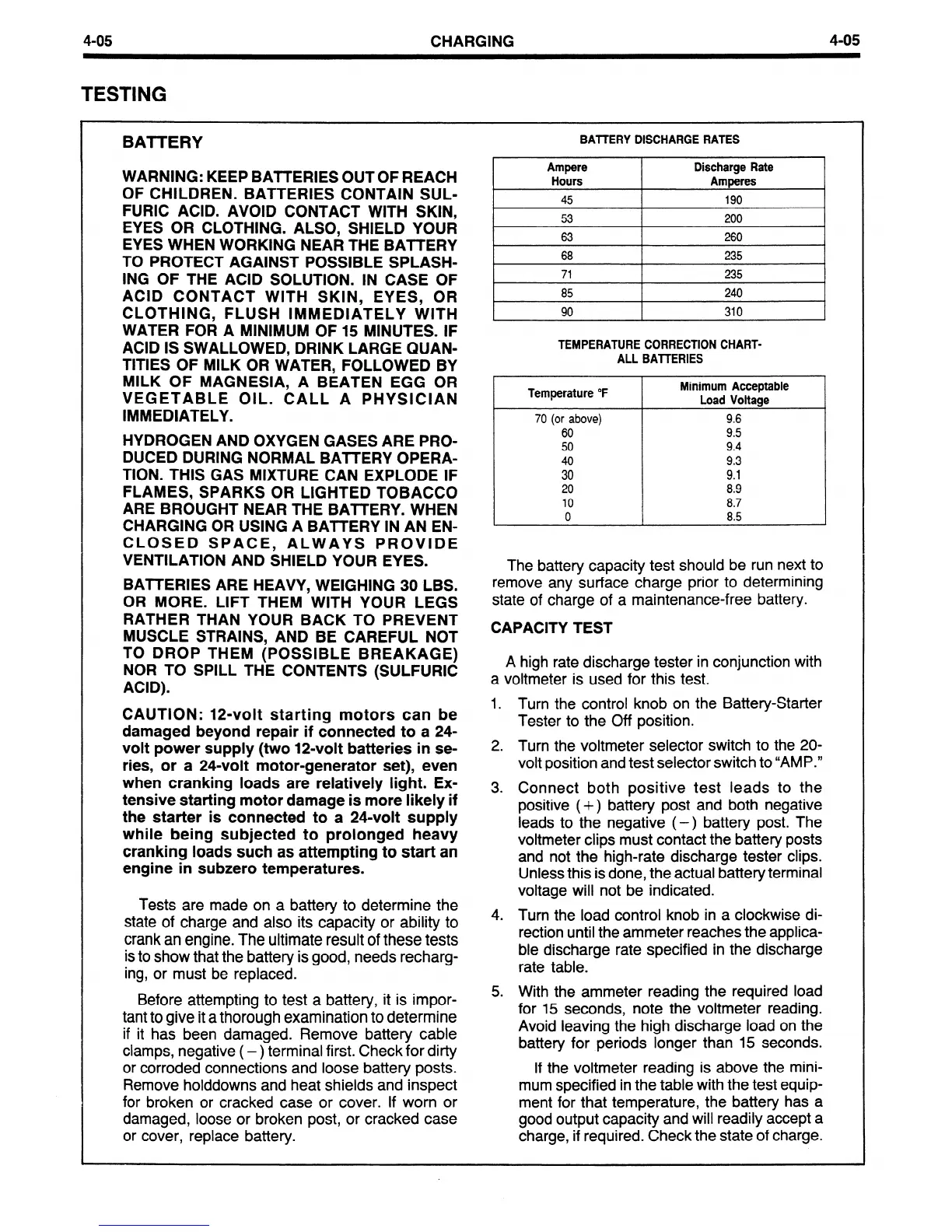4-05
CHARGING
4-05
BATTERY
BATTERY DISCHARGE RATES
WARNING: KEEP BATTERIES OUT OF REACH
OF CHILDREN. BATTERIES CONTAIN SUL-
FURIC ACID. AVOID CONTACT WITH SKIN,
EYES OR CLOTHING. ALSO, SHIELD YOUR
EYES WHEN WORKING NEAR THE BATTERY
TO PROTECT AGAINST POSSIBLE SPLASH-
ING OF THE ACID SOLUTION. IN CASE OF
ACID CONTACT WITH SKIN, EYES, OR
CLOTHING, FLUSH IMMEDIATELY WITH
WATER FOR A MINIMUM OF 15 MINUTES. IF
ACID IS SWALLOWED, DRINK LARGE QUAN-
TITIES OF MILK OR WATER, FOLLOWED BY
MILK OF MAGNESIA, A BEATEN EGG OR
VEGETABLE OIL. CALL A PHYSICIAN
IMMEDIATELY.
HYDROGEN AND OXYGEN GASES ARE PRO-
DUCED DURING NORMAL BATTERY OPERA-
TION. THIS GAS MIXTURE CAN EXPLODE IF
FLAMES, SPARKS OR LIGHTED TOBACCO
ARE BROUGHT NEAR THE BATTERY. WHEN
CHARGING OR USING A BATTERY IN AN EN-
CLOSED SPACE, ALWAYS PROVIDE
VENTILATION AND SHIELD YOUR EYES.
BATTERIES ARE HEAVY, WEIGHING 30 LBS.
OR MORE. LIFT THEM WITH YOUR LEGS
RATHER THAN YOUR BACK TO PREVENT
MUSCLE STRAINS, AND BE CAREFUL NOT
TO DROP THEM (POSSIBLE BREAKAGE)
NOR TO SPILL THE CONTENTS (SULFURIC
ACID).
CAUTION: 12-volt starting motors can be
damaged beyond repair if connected to a 241
volt power supply (two 12-volt batteries in se-
ries, or a 24-volt motor-generator set), even
when cranking loads are relatively light. Ex-
tensive starting motor damage is more likely if
the starter is connected to a 240volt supply
while being subjected to prolonged heavy
cranking loads such as attempting to start an
engine in subzero temperatures.
Tests are made on a battery to determine the
state of charge and also its capacity or ability to
crank an engine. The ultimate result of these tests
is to show that the battery is good, needs recharg-
ing, or must be replaced.
Before attempting to test a battery, it is impor-
tant to give it a thorough examination to determine
if it has been damaged. Remove battery cable
clamps, negative ( - ) terminal first. Check for dirty
or corroded connections and loose battery posts.
Remove holddowns and heat shields and inspect
for broken or cracked case or cover. If worn or
damaged, loose or broken post, or cracked case
or cover, replace battery.
Ampere Discharge Rate
Hours Amperes
I
45
I
190
I
1
53
1
200
I
I
63
I
260
I
I
68
I
235
I
I
71
I
235
I
I
85
I
240
I
I
90
I
310
I
TEMPERATURE CORRECTION CHART-
ALL BATTERIES
Temperature OF
Minimum Acceptable
Load Voltage
70 (or above)
9.6
60
9.5
50
9.4
40
9.3
30
9.1
20 8.9
10
8.7
0
8.5
The battery capacity test should be run next to
remove any surface charge prior to determining
state of charge of a maintenance-free battery.
CAPACITY TEST
A high rate discharge tester in conjunction with
a voltmeter is used for this test.
1. Turn the control knob on the Battery-Starter
Tester to the Off position.
2. Turn the voltmeter selector switch to the 20-
volt position and test selector switch to “AMP.”
3. Connect both positive test leads to the
positive ( + ) battery post and both negative
leads to the negative (-) battery post. The
voltmeter clips must contact the battery posts
and not the high-rate discharge tester clips.
Unless this is done, the actual battery terminal
voltage will not be indicated.
4. Turn the load control knob in a clockwise di-
rection until the ammeter reaches the applica-
ble discharge rate specified in the discharge
rate table.
5. With the ammeter reading the required load
for 15 seconds, note the voltmeter reading.
Avoid leaving the high discharge load on the
battery for periods longer than 15 seconds.
If the voltmeter reading is above the mini-
mum specified in the table with the test equip-
ment for that temperature, the battery has a
good output capacity and will readily accept a
charge, if required. Check the state of charge.
